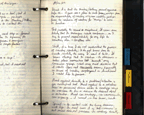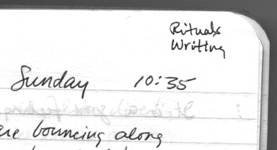
Your Journal Must Have Structure.
To be of any use, your Journal must have some kind of structure ... some means by which you can find important links weeks, months, perhaps years later. A disorganized Journal is as useful as a cluttered closet, or the legendary ‘junk drawer.’ “You know it’s there somewhere,” but you can never find it when you want it.
 The
structure can be simple or complex. Generally speaking, the simplest structure
for you is the best. Again, structure itself must not interfere
with the enjoyment you gain from the experience of writing in your Journal.One
Journal writing expert instructed his students to set up their Journals
with very specific sections, cross-referencing dates and events that related
to each other. It was very structured and works for many people.
The
structure can be simple or complex. Generally speaking, the simplest structure
for you is the best. Again, structure itself must not interfere
with the enjoyment you gain from the experience of writing in your Journal.One
Journal writing expert instructed his students to set up their Journals
with very specific sections, cross-referencing dates and events that related
to each other. It was very structured and works for many people.
Personally, I found it difficult to navigate through the Journal and gave it up.
 At
the very least, your Journal should indicate the range of dates covered;
each new entry should have the date (month, day and year), day
of the week and the time. If you are in a special place,
you should note that as well, with a description of your surroundings,
and perhaps a brief review of the events leading to your being at that
place.
At
the very least, your Journal should indicate the range of dates covered;
each new entry should have the date (month, day and year), day
of the week and the time. If you are in a special place,
you should note that as well, with a description of your surroundings,
and perhaps a brief review of the events leading to your being at that
place.
Take note of the time in various places during the session, particularly before breaks – in longer sessions – and certainly at the end. Doing so often gives a sense of the pace of the session. Some sessions are more difficult and take longer. Such information can be useful later.
Finally, experiment with coding the first page of some particularly important sessions, ones to which you are certain to want to review again later, or that are parts of recurrent themes. Such coding can help you more quickly find passages and sessions you want to review later.
By Gerry Starnes • All rights reserved.